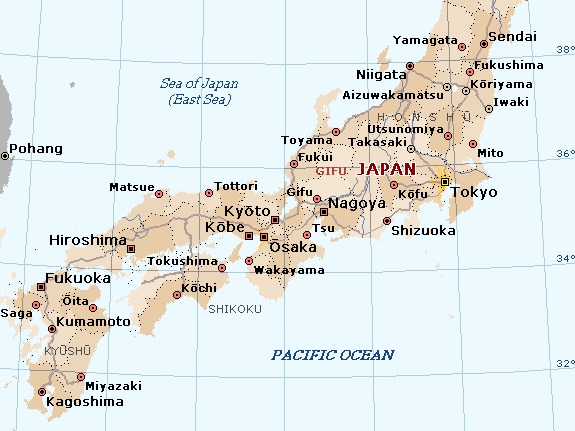
Jomon Period (13000 – 300 BC) :
Hunting and Gathering
Fishing becomes more and more central to existence
An increase in producing crafts and ritual objects
Descendants of Jomon people most likely Ainu
1st Emperor (Jimmu, descendant of sun goddess Amaterasu) comes into power around 660 BC (or so the story goes).
Jomon History Page
Shintoism -
As old as Japan itself, no founder
Animistic
No written texts like the Koran or Bible
People become spirits/gods (kami) after they die
No absolute wrong or right: people are good,
but can be affected by evil spirits
Purification is therefore very important
Yayoi Period (300 BC – 300 AD):
Rice cultivation is brought, bringing social classes and the beginnings of the feudal culture
- from China via Korea
Innovations such as iron are brought from Korea
Kofun Period (300 – 538 AD):
in 400 Japan is unified into Yamato Japan, with the seat of government in present day Nara. The Emperor (Yamato) is the symbolic head of state. However, any real authority is soon usurped by the Soga family.
Close relations with Korea begins at end of 4th c.
Innovations of the time include:
- Buddhism (538), Confucianism, Taosim
- Chinese writing system
- Aristocratic society with military leaders at the helm
The Myth of Creation (680 AD)
The Kojiki is the creation myth that is central to many of the tenets in Shintosim
Nara Period (710-794):
The seat of government is located in the same place as the seat of Buddhism
Heian Period (794-1185):
Noted for its Art and Literature
Fujiwara clan took power from the Sogas
- New Governmental and Administrative systems
- Government bought all land and redistributed it among landowners
- New tax system adopted from Chinese model.
These land reforms were a huge failure for various reasons
- Taxes were too high.
- Farmers had to sell their land and become tenants.
- Buddhist temples and aristocrats were immune from taxation, so less money was collected overall
As a result, power shifted away from government and towards large landowners
- Minamoto Clan
- Taira
- Fujiwara
- Tachibana
Buddhism becomes a major part of Japanese culture
- Influence is so strong that the capital has to be moved from Nara to Kyoto (Heian).
A movement away from Chinese influence and towards “Japanization” starts
- Kana system of writing
- Native arts are given more attention.
The Fujiwara clan rules for nearly a century, but at the end they lose their grip and society becomes quite unruly.
This leads to wealthy landowners hiring samurai for protection.
Fujiwara clan’s power is usurped by Go-Sanjo
- Go-Sanjo’s intention to reclaim emperor’s power
- Successful, but only for a while (1086-1156)
The rise of two families to power
- Minamotos (Genjis) – covered military side
- Tairas (Heike) – covered political side
Taira Kiyamori rules through the emperor for about ten years
The Minamotos eventually defeat the Tairas in the Gempei war (1180-1185)

The Japanese Middle Ages (Kamakura, Muromachi, and Azuchi-Momoyama Periods 1185-1600)
- Japan is now governed by Samurai clans, under the direction of the Shogun
- Minamoto Yoritomo is the new shogun
- Government is moved to Kamakura
- Japan invaded by Mongols (1272) but repelled by Divine Wind (Kamikaze)
- This eventually causes a rift with the Kyoto center of government
- Minamotos defeat the royal army and redistribute land again.
- Because of money and energy expended on Mongol invasions, the emperor (Go-Daijo) is able to regain control.
- But he is soon overthrown in turn and Japan splits into North and South Governments.
- they battle for over 50 years
- Southern court finally surrenders in 1392 and Japan is united once more (sort of)
- The age of civil wars starts, with several landowners fighting over land and money
- Daimyo exert actual control
- Oda Nobunaga makes the first big steps in actually uniting Japan in the mid 16th century.
- 1543 - First contacts with the West, in the form of Portuguese traders
- The art of Sumi-e is introduced to Japan by Zen Buddhist Monks from Korea.
Outside Links:
Religious Tolerance Overview of Shintoism
Okami and Japanese Mythology - the vidogame
The Kojiki in Manga Form
Comments (0)
You don't have permission to comment on this page.